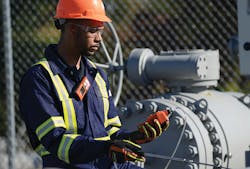Tom is out walking on his daily check of the company pipeline. It is a beautiful day, with a clear blue sky, low humidity and a nice breeze. As Tom walks along, he notices a patch of dead grass in the middle of the right of way. It’s near the end of his assigned area for the day, so he decides to check it out, interested to know why the grass is dead there and bright green everywhere else.
As Tom gets close, his gas meter starts to alarm. He quickly thinks back to his gas meter training class, trying to remember what the trainer said about gas levels and how they will affect the human body when they become dangerous.
The cadence on his meter changes and he notices that it has gotten louder and more pronounced, and now, all of a sudden, he is feeling lightheaded. Before Tom can turn around and head back to his truck he falls to the ground. Tom’s last thought as his eyes close is, “Who is going to know what happened to me and where I am?”
When it comes to responding to an emergency, what are the biggest factors that affect the outcome? How long it takes to get the alert to first responders? Whether the alert provides detailed information like the alarm type, the victim’s location and current gas readings? When we say alarm type, we need to know if it is a gas, panic or man-down alarm. Location can have a huge effect on the outcome as well, depending on what types of rescue vehicles the responders might need to bring.
If the incident occurs on a pipeline out in a rural area, an ambulance crew might need to request a fire department with a UTV or four-wheel drive vehicle for patient handling. For these reasons, knowing the location and alarm type in real-time go a long way in helping to improve the timeliness and effectiveness of emergency responders.
When it comes to gas detection, data has undergone a slow evolution. Historically, workers relied on memory to recall when a gas alarm occurred. The introduction of docking stations and computer link devices allowed you to download the information directly from the instrument. With this advancement, you had more insight into the alarm that occurred such as: date and time of incident, highest readings, average readings, time-weighted average (TWA) and short -term exposure limit (STEL). Detailed alarm information is invaluable to the post-incident investigation, but when it comes to emergency response, we are more concerned about what is happening and where it’s happening, in real time.
Real-time gas alerts have been around for a few years and are becoming more prevalent. Some companies have integrated their gas meters with Wi-Fi connections that will transmit data back to central controller boards. This is great when you always have someone at the board watching the users who can dispatch the proper emergency response team when issues occur. Drawbacks of this new technology include the cost of Wi-Fi infrastructure and figuring out how to handle offsite locations that do not have a link back to the central controller. Additionally, you always must have someone watching the board so they can respond to an incident.
There also are companies with meters linked to cell phone networks, either through a cellular radio in the device or using Bluetooth back to an existing cell phone. This option is great because it allows the cell towers to transmit the data back anywhere that you have cell service. Using intrinsically safe smart phones, you now can transmit real-time data in refineries and other areas where cell phone use was a concern. Using the phone’s GPS capability, first responders will know the exact location of the victim. Once the instrument goes into alarm, there are multiple ways to get data to the safety manager, including text message, email or even an automated phone call. For areas where a cell phone won’t work, there are other communication gateways available. These gateways allow the meter the ability to send the data via cellular, Wi-Fi or satellite and some are designed to be mounted in a truck for mobile operations.
Local alerts also can be helpful for first responders. Some gas monitors can communicate with one another as part of a wireless, peer-to-peer network without needing additional hardware or a central controller. This can be extremely helpful in confined spaces where workers inside are sending data directly from their gas monitors to the hole watch attendant. When using tubing to draw air from inside the space to the attendant outside, there can be a delay in the readings. With real-time alerts coming from the meter inside, the attendant knows when the user has encountered a gas or triggered a man-down alert. This allows the attendant to activate the appropriate emergency response plan immediately. When it comes to any emergency, the more data you can provide in real-time to first responders, the better the rescue outcome.
Tom hears muffled voices around him and feels the oxygen mask over his face. He’s being bounced around and he’s strapped into a stokes basket. His eyes slowly open and he sees firefighters wearing SCBA’s walking next to him.
When they get him to the ambulance, the paramedic starts talking to him and checking him over. Tom’s supervisor also is there. He explains how he got the text message with Tom’s location and high gas readings, and just as he was trying to call Tom to check on him, he received the man-down alert. He immediately called 911 and gave them Tom’s location along with the gas readings. Using that information, the fire and EMS personnel knew they needed to use their SCBAs so that they did not become overwhelmed by gas during the rescue. Thanks to the real-time alerts from Tom’s meter being sent to someone who could get help, Tom was able to go home to his family and not become a statistic.
John Onuska is a training specialist with Industrial Scientific and a Lieutenant in the South Beaver Volunteer Fire Department in South Beaver, Pa. He can be reached at [email protected].
About the Author
John Onuska
John Onuska is a training specialist with Industrial Scientific and a Lieutenant in the South Beaver Volunteer Fire Department in South Beaver, Pa. He can be reached at [email protected].

